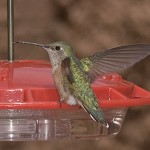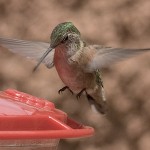When capturing hummingbird images, my habit has been to work morning or evenings on bright sunny days to get enough sunlight on the birds for the shutter speeds I wanted. For a large part of the day, the sun was too high to light the undersides and the wings and beak cast even deeper shadows on their bodies. The best time for me to work on hummingbird images in natural light was between 8 and 9 a.m. on a cloudless day.
The birds didn’t always cooperate much during my prime time, but I was able to get some nice images and I was happy. The bright feathers on the neck or gorget of the males would reflect the brilliant color in my image if the bird was at the right angle. With my back to the sun I hoped the bird would be turned just enough toward the sun to get the reflection of bright color coming my way.
I’d read about others who photograph hummingbirds using one or more flashes to light the shadows and ensure the reflection from the neck or gorget feathers on the colorful males and I had all sorts of excuses for not trying it myself. I thought that lighting up the birds might scare them or annoy the birds. I didn’t want the images to look unnatural. I didn’t want to be tied down with a lot of heavy lighting equipment since I like to move frequently from one location to another. I didn’t want to spend a lot of money on flash equipment. Yet, I kept reading about how much lighting the birds could improve my images.
I continued reading and making excuses for my lack of lighting until I visited with photographer George Lepp at a hummingbird festival recently. Mr. Lepp’s set up was simpler than I thought it would be and though he did have a second slave flash set up, he told me I could really improve my hummingbird photography with just one flash unit on the camera.
I got the Canon 580EX II. It arrived a few days ago along with a flash extender also recommended by Mr. Lepp. When the flash arrived I did some indoor practice with camera and flash settings. (Why does new equipment arrive on very windy and rainy days?) Today I was ready to go out and light some little birds. The broadtail below is my first (and only) flash hummingbird. You may click on an image to see it larger.
- flash
- without flash
- flash
- without flash
- flash
The flash only fired every third capture in the high speed shooting mode. I’m recharging the batteries to see if I can improve that. If it doesn’t improve with fresh batteries, I may check into an additional battery pack, like the ones Mr. Lepp had connected to his flash units.
I don’t usually photograph at this particular feeder location because the background isn’t very pretty, but that’s where the bird went and I followed. I also don’t usually photograph them on the feeders, so next I shall try flashing the hummingbirds as they hover around the wild current flowers.
After reading Mr. Lepp’s column in Outdoor Photographer for a few years, it was interesting to meet him and his wife, Kathryn. Now, thanks to the Lepps sharing photography tips with people at the hummingbird festival, I’m hoping to improve my hummingbird photography.





I know what you mean about all the extra equipment. A photographer I know uses about 5 flashes for various aspects in the capture – still wings, background, etc. I imagine it is like fireworks around that little bird for every exposure!
Interesting post. I prefer no flash too and little extra equipment. Guess I’ll just keep plugging away, hoping for good lighting.
Ok, I’m back. The first images I took today were of a hummingbird at the feeder (I know, you prefer no feeders, but birdfeeding is what my blog is all about) and through a window. Inspired by your post, I turned on the integrated flash. One of the resulting images is now my new banner! http://wildbirdsunlimited.typepad.com.
Thanks for the inspiration and the needed “duh” moment.
I just love hummingbirds, and am simply amazed at how they fly. I’m also amazed that the flash doesn’t flip him out!
The photos are great! I like the 2nd on with out the flash the best, despite the shadow. Nice work!
Mark and Zen B. and Tracy – Thanks for commenting.
If hummingbird photography was all I wanted to do I might be tempted to go for a more complicated lighting system (like Mark’s friend) in my quest for better images. I do rather prefer the challenge of finding the light to buying and setting up the light.
I like the new banner image at Zen Birdfeeder and glad my post inspired your experimentation with flash. And yes, I prefer no feeders in the image, but you see where I went to begin my lighting practice. I like images of the birds in more natural settings, but often practice around the feeders so I’ll be ready for other hummingbird opportunities.
I like the 2nd image with tail feathers spread, too, Tracy. Sometimes the shadows are so deep on the underside of the birds that the contrast is way too high for a pleasing image. It was cloudy the day I captured these images, so sans flash worked pretty well, even though I was photographing at noon, something I would never have tried without the flash on a sunny day. It’s all rain and fog today, so I’ve yet to see what I can do with the light on a sunny day.